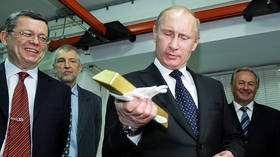No quick bounce back: Russia’s real GDP to recover in mid-2022 but ruble to remain strong, Economy Ministry says
Russia’s Ministry of Economic Development has released a fresh forecast for 2019-2022. The ministry said there will be no V-shaped recovery: after a five percent plunge in 2020, real GDP will only recover starting in mid-2022.
The Ministry of Economic Development predicts a GDP growth of 2.8% in 2021 and three percent in 2022.
The Urals price remains below the base budget price of $42, at which point the Russian budget breaks even. Urals will average $31.1 per barrel this year, rising to $35.4 in 2021. Only in 2022 will it return to the breakeven price of $42.2 when Russia Inc. goes back into profit.
That means the Ministry of Finance will rely on the National Welfare Fund (NWF) to top up budget spending until 2023. Currently there are some nine trillion rubles ($130bn) of liquid assets in the NWF. With an estimated three-trillion-ruble shortfall in budget revenues forecast for this year, there is therefore enough in the NWF to cover at least another three years of deficits.
Also on rt.com E-commerce may be the driver for expansion of Russian businesses in ChinaThe ministry also says the ruble will remain relatively strong over the period. The ruble was trading at an average rate of 64.7 rubles to the dollar in 2019 before the start of the oil price shock and the corona crisis, but it sank to a low of 80 rubles amid the panic that followed. It has since recovered to break below 70 rubles again in the first weeks of June.
The Ministry of Economic Development predicts that the FX RUB/$ rate will average 72.6 rubles to the dollar this year. After that the rate will go to 74.7 in 2021 and 73.3 in 2022.
Real incomes will decline 3.5% in 2020 after growing for the first time in six years by an average of 2.9% in 2019. But real wage growth will recover next year, up by 3.1% and two percent in 2021 and 2022 respectively.
At the same time, unemployment will remain at an elevated level of 5.7% this year, up from 4.6% in 2019, before diminishing slowly over the next two years to 5.4% and then 4.9%.
The fall in oil prices will also put pressure on the balance of payments, but those will remain positive throughout. Russia ran a $65 billion trade surplus in 2019 that will fall to a mere nine billion this year, before recovering very slowly to $10 billion and $27 billion over the next two years.
Also on rt.com Back in business? Moscow economy almost back to normal as capital lifts lockdownThe current account is also expected to halve this year to $45 billion but the Ministry of Economic Development offered no forecast on this number. Opinion is divided amongst analysts on what will happen to the current account. The Central Bank of Russia (CBR) said last month that the current account may go negative for the first time in a decade this year after oil prices fell to around $25; more recently, however, analysts at BCS Global Markets predicted that Russia will earn $45 billion this year, after oil prices recovered surprisingly quickly.
Among the other predictions, the Ministry of Economic Development estimates that inflation at the end of the year will go from three percent in 2019 to four percent this year and stay at that level for the next two years – at the CBR’s target rate.
Amongst the more depressing forecasts is that investment will shrink by 12% this year from the meagre 1.7% growth in 2019, but that it will recover to 4.9% and 5.6% in 2021 and 2022 respectively.
The low level of inflation is the bugbear in Russia’s otherwise strong macro-fundamentals picture. The level of investment is equivalent to 20.6% of GDP in 2019, 20.1% in 2020, 20.7% in 2021 and 21.1% in 2022 – but economists say that investment needs to rise above 25% per year if Russia is to break out of its current cycle of stagnation.
For more stories on economy & finance visit RT's business section














